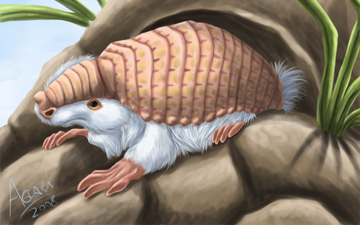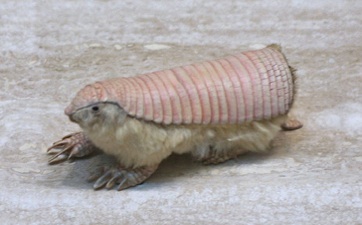The pink fairy armadillo (Chlamyphorus truncatus) or pichiciego is the smallest species of armadillo (mammals of the familyDasypodidae, mostly known for having a bony armor shell). It is found in central Argentina, where it inhabits dry grasslands and sandy plains with thorn bushes and cacti.
The pink fairy armadillo is approximately 90–115 mm (3.5-4.5 inches) long, excluding the tail, and is pale rose or pink in color. It has the ability to bury itself completely in a matter of seconds if frightened.
It is a nocturnal animal. It burrows small holes near ant colonies in dry soil, and feeds mainly on ants and ant larvae near its burrow. Occasionally, it feeds on worms, snails, insects and larvae, or various plant and root material.
The pink fairy armadillo spends much of its time under the ground, as it is a “sand swimmer” similar to the golden mole or the marsupial mole. It uses large front claws to agitate the sand, allowing it to almost swim through the ground like it is water. It is torpedo-shaped, and has a shielded head to prevent abrasion from the sand.
In 1996, the species was classed as endangered by the IUCN,[2] then upgraded to “near threatened” in 2006, and in 2008 changed to “data deficient”,[2] despite concern over habitat destruction, particularly due to cattle farming.[2]
This armadillo is found in several protected areas, including the Lihué Calel National Park.[2] Both national and provincial legislation is in place specifically protecting the species.
(From Wikipedia, 23 June 2012)
This smallest of all armadillo species is endemic to central Argentina, where it is found in the provinces of Buenos Aires (southern part only), Catamarca, Cordoba, La Pampa, La Rioja, Mendoza, Rio Negro, San Juan and San Luis.
These armadillos prefer to burrow in very dry soil. They leave their burrows if it is moistened by rainfall. These animals often burrow near anthills, so that they can be close to their food source.
These armadillos are omnivores, but they feed mainly on ants. Occasionally they eat worms, snails, and various plant and root materials.
(From EOL, 23 June 2012)





